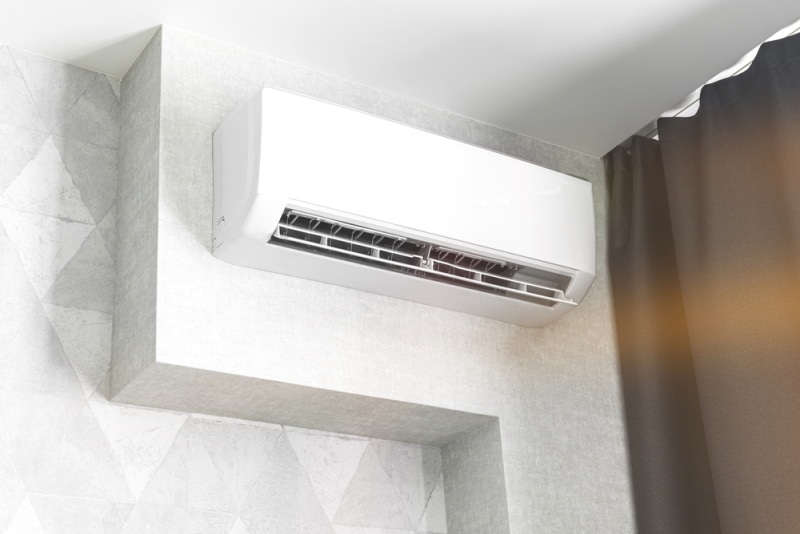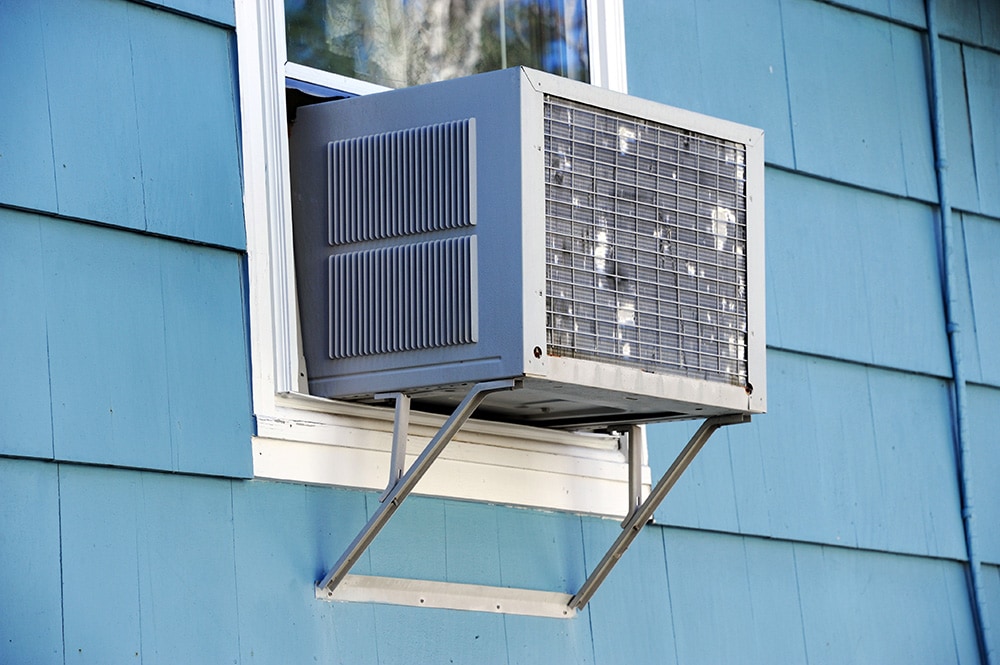Who Invented the Air Conditioner? History & Benefits
-
Pete Ortiz
- Last updated:

You know what it can be like during summer—hot and uncomfortable. Many of us open the windows or use a fan and wait for the house to cool down. But technology has come a long way over the years with the advent of the first air conditioner by Willis Haviland Carrier 17th July 1902.1
An air conditioner cools and dehumidifies the air in a room or other enclosed spaces by removing heat from the air and transferring it to the outside air.
While many of us enjoy air conditioning, only a few know the history behind the invention of the original air conditioner or how it all started. Today, we’ll take a deeper look into the history of this handy device. Let’s dive in!
History of the Air Conditioner
An air conditioner is one of the most important inventions of the 20th century, an ingenious idea to bring comfort to homes. The history of air conditioning is a long one, but let’s start from the beginning!
1. The 1700s: Benjamin Franklin and John Hadley Performed the First Documented Test for the Air Conditioning Theory
The history of the air conditioner can be traced back to the 1700s. In 1758, John Hadley and Benjamin Franklin performed the first air conditioning test. During this time, there was a lot of research on heat transfer and how air cooled down to maintain a comfortable environment.
They started experimenting with alcohol and other liquids that evaporate faster than water. They placed these liquids on the bulb of a mercury thermometer. The two inventors discovered that as the liquids evaporated, there would be a temperature drop. They also found out that volatile liquids were best at cooling an object below the water’s freezing point.
2. The 1800s: More Air Conditioner-Related Inventions by Michael Faraday and John Gorrie
In 1820, Michael Faraday (an English inventor and scientist and one of the most prominent scientists in history discovered that ammonia would change to liquid if you compact it.2 When this liquid evaporated, it would cool the air inside a room.
Later in 1842, John Gorrie (a physician in Florida) constructed an ice-making appliance. It compacted water and air to form ice. He was trying to develop a machine that would allow him to treat patients suffering from yellow fever, a disease prevalent in the region at the time. It helped keep his patients cool.
John Gorrie received his ice-making appliance patent in 1852. It envisaged a world filled with appliances to keep everyone worldwide cool. But John didn’t realize his dream due to lack of funds. He later died in 1855.
3. The 1900s: ‘The Father of Air Conditioning’ Willis Carrier Invented the First Air Conditioner
Willis was the Principal Engineer of the Buffalo Forge Firm in the United States from 1902 to 1915. He invented the first electricity-powered air conditioner in 1902. That’s why he is called “The Father of Air Conditioning.”
His invention was called “Apparatus for Treating Air.” It used a compressor, condenser, evaporator, and fan to push cold air into rooms through vents or ducts.
Carrier was looking for a way to cool his printing business in Newark, New Jersey. He was inspired by a demonstration of refrigerated air in a store window. He designed an air-cooled system based on how refrigerators work.
The system used water to absorb heat from the air. Then, it was released back into the room, where it cooled down again. It was called an ‘absorption chiller’ because it absorbed heat from the air.
Carrier’s company sold these systems to big businesses like hotels and theaters. They were expensive, so not many people could afford them.
Four years after Carrier’s invention, Stuart Cramer surveyed for ways to increase humidity in the air inside his textile mill. So, he invented a ventilating appliance. It combined ventilation with humidity to condition the air inside his factories.
Cramer called this procedure “air conditioning.” Willis Carrier adored the name and decided to endorse this term. He also integrated it into his company’s name.

4. The 2000s: Modern-Day Air Conditioners
Today, there are different types of air conditioners available on the market. They all work in slightly different ways, but they have one thing in common: they use refrigerants to absorb heat inside a room, then release it outside through coils mounted on their exteriors.
Air conditioning is a staple of modern life. For example, nearly 90% of homes in the United States have air conditioning.3 While the technology behind air conditioning has been around since the late 19th century, it’s now becoming common in American homes and businesses as well as in many other countries worldwide.
Modern-day air conditioners can be divided into two primary categories, room air conditioners and central air conditioning systems.
Room Air Conditioners
A room air conditioner is a cooling unit you can install to cool one room or area. They come in different sizes, ranging from small units that can cool one small room to large units that can cool large rooms.
Central Air Conditioning Systems
Central air conditioning systems circulate cooled air throughout the entire house through a series of ducts and registers. They’re more expensive than room air conditioners, but they do not need installation in every room. Instead, they rely on one main unit called an outdoor condenser unit connected to many indoor units called evaporators.
The outdoor condenser unit sits outside your home. It has a fan that sucks out hot air from inside before blowing it outside through condenser coils. Here, heat is removed from refrigerant gas as it moves through them.
5. The Future of Air Conditioning

We’re living in an age of unprecedented technological advancement. It includes the way we cool our homes. The smart air conditioner is the future of air conditioning. It’s getting smarter as time goes on and technology advances further.
Benefits of Having a Smart AC System Installed in Your Home
- Energy Efficiency: A smart AC system can be programmed to turn on and off at certain times of the day. It saves energy when you don’t need it and turns on automatically when you need it. Smart AC systems also have sensors that detect when no one is in the room or house. This way, they don’t waste energy cooling the space!
- Reduced Carbon Footprint: The world is changing, and so is the way we think. We are now more conscious about the things we do, and how they affect our planet. One such change is towards green energy and its use. Smart Air Conditioning systems use this idea to their advantage.
These systems turn on automatically when they detect a room is getting too hot or cold. Then, they turn off automatically when the desired temperature is reached. This feature doesn’t waste energy. So, it reduces carbon footprint.
- Error Diagnosis and Preventive Maintenance: Smart air conditioning systems diagnose faults. They have sensors that detect problems with the system before they cause severe damage to your home. The error diagnosis feature will alert you if there’s a problem with your air conditioning system. This way, you can repair it before it becomes a big issue.
Here are several outstanding features of the smart AC system. Take a look!
- Geolocation Feature: It determines the device’s location and adjusts its operation. This feature allows you to control your AC from anywhere in the world using your smartphone or tablet. You can turn the AC on or off, set temperatures, and start/stop timers from anywhere as long as you have an internet connection.
- Smart Home Integration: An air conditioner can communicate with other smart devices in your home. Smart air conditioning systems are compatible with other smart home devices like Google Assistant and Apple Home Kit. You can control your AC using voice commands. You can also use an app on your phone or tablet.
- Smart Weekly Scheduling: Smart air conditioners have an automatic scheduling feature. It will allow you to set up weekly timers for your unit to run at different times each day. It helps you save energy by ensuring your home is cooled only when needed.
- Usage Details: A smart air conditioner can track the number of hours the system is used when it’s used, and how much energy is consumed during each use. This information can help determine whether you need to adjust your cooling schedule. You can also determine if there are areas in your home that need more ventilation.
Conclusion
Willis Carrier is credited for bringing the air conditioner into being. He was a visionary innovator in so many ways, and it’s easy to see why he’s a legend in the field of Air Conditioners. We can enjoy the benefits of air conditioning because of his insight and desire to make life more comfortable — in our environments, offices, and homes.
The story of Willis Carrier is a remarkable one. It’s an excellent example of how a simple idea can change the world. A simple air conditioner revolutionized people’s lives. Reading this article will inspire you to become more knowledgeable about the incredible world of air conditioning.
- You Might Also Be Interested In: Makita MAC5200 Air Compressor Review
Featured Image By: FellowNeko, Shutterstock
Contents


